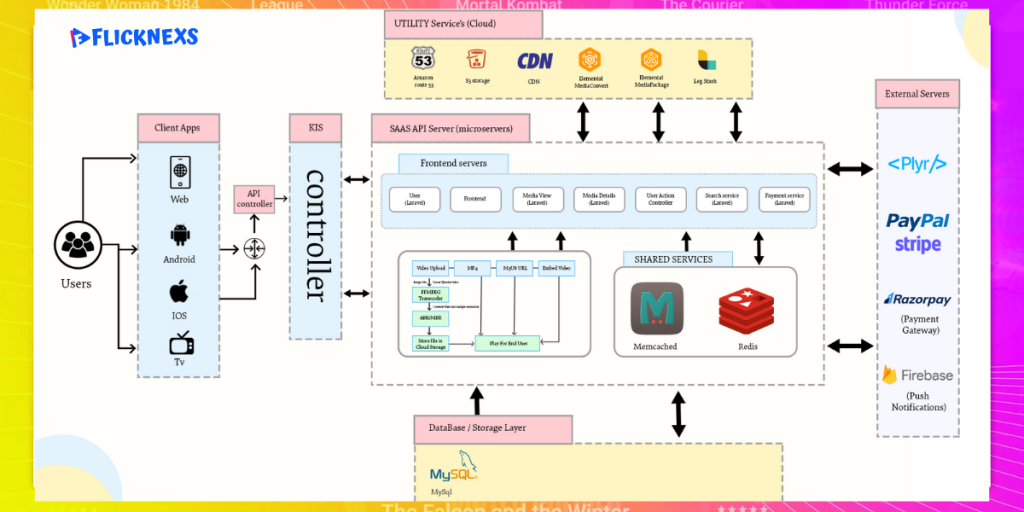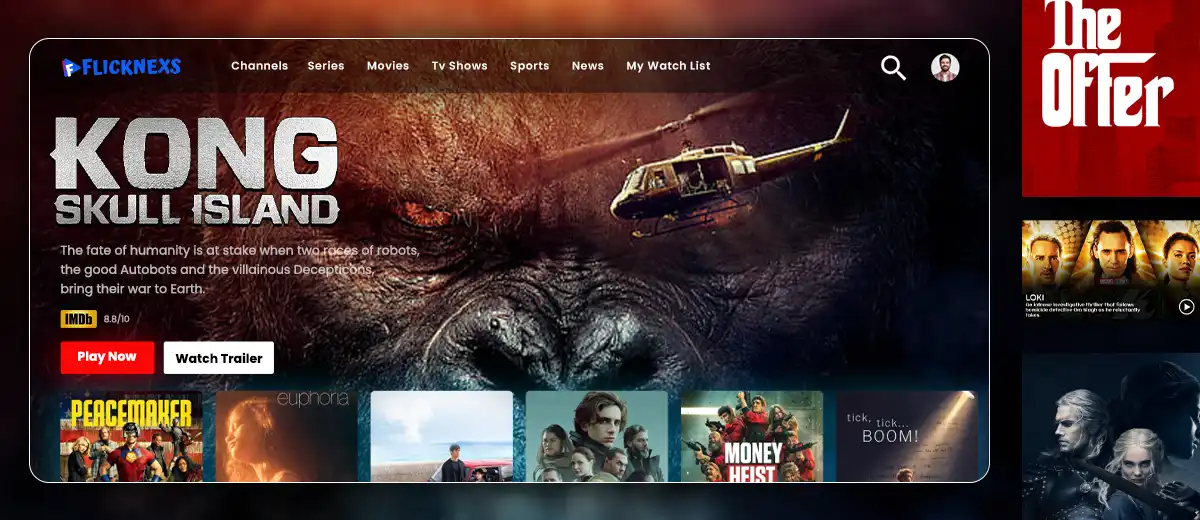In today’s digital era, watching TV has transformed from a traditional cable or satellite connection to online streaming services.The rise of OTT platforms has revolutionized the way we consume entertainment, but what is OTT? Let’s dive in and explore the concept in detail.
“OTT is more than just streaming – it’s a game-changer that’s transforming the way we watch TV.”
The entertainment industry has undergone a significant transformation in recent years, with the rise of digital platforms and streaming services. One of the key developments in this landscape is the emergence of Over-The-Top content. It refers to the delivery of video content through the internet, bypassing traditional cable or broadcast providers. In this article, we will provide a comprehensive guide to understanding OTT, its workings, advantages, and challenges.
What is OTT?
It stands for “over-the-top” and refers to the delivery of content (such as movies, TV shows, and other videos) over the internet, rather than through traditional methods like cable or broadcast TV.
OTT is a way to stream video content over the internet, providing greater flexibility and accessibility than traditional broadcast TV.
Importance of understanding OTT
- Understanding OTT (Over-The-Top) is crucial as it revolutionizes traditional media consumption, enabling on-demand access to diverse content anytime, anywhere.
- OTT has transformed the entertainment industry, offering increased choice, personalized experiences, and flexibility, making it essential to grasp its impact on content creation and distribution.
- Knowledge of OTT helps businesses adapt to changing consumer preferences, allowing them to reach wider audiences and tap into new revenue streams.
- Understanding OTT empowers advertisers to effectively target specific demographics and measure the impact of their campaigns, optimizing their marketing strategies.
- OTT’s disruptive nature necessitates a comprehensive understanding to navigate evolving regulations, copyright issues, and market dynamics for both content creators and consumers.
How OTT differs from traditional TV and cable
It is differs from traditional TV and cable in that it provides video content through the internet, allowing consumers to access a wide range of content from various sources.
OTT (Over-The-Top) content delivery refers to the distribution of video content over the internet directly to viewers, bypassing traditional cable, satellite, or broadcast television platforms. Here are some key differences and important points that highlight the distinctions between OTT and traditional TV/cable:
Content Delivery:
- OTT: Content is streamed over the internet, allowing viewers to access it on various devices (smartphones, tablets, smart TVs, etc.) using an internet connection.
- Traditional TV/Cable: Content is delivered through cable or satellite providers and is typically limited to specific channels or packages available within a subscribed plan.
Flexibility and Accessibility:
- OTT: Offers on-demand viewing, allowing users to watch content at their convenience. Viewers have more control over what they watch, when they watch it, and on which devices.
- Traditional TV/Cable: Primarily offers scheduled programming with limited on-demand options. Viewers have less flexibility and need to adhere to preset broadcasting schedules.
Content Variety and Customization:
- OTT: Provides a vast array of content options, including movies, series, documentaries, and user-generated content. Users can often personalize their viewing experience through recommended algorithms and customizable profiles.
- Traditional TV/Cable: Typically offers predefined channel packages with limited customization options. Content choices are usually determined by the provider’s packages or subscriptions.
Adaptability and Innovation:
- OTT: Tends to be more adaptable to technological advancements and consumer preferences. Often integrates new features, interactive elements, and user-friendly interfaces to enhance the viewing experience.
- Traditional TV/Cable: Might be slower to adapt to new technologies and innovations due to established infrastructure and regulatory constraints.
Subscription vs. Advertising Revenue:
- OTT: Often relies on subscription-based models (e.g., Netflix, Disney+, Hulu) and, in some cases, a combination of subscriptions and advertising (e.g., Hulu’s ad-supported tier).
- Traditional TV/Cable: Relies heavily on advertising revenue, although subscription-based models like premium cable channels (HBO, Showtime) also exist.
Global Reach and Market Expansion:
- OTT: Has a global presence and can reach audiences worldwide without geographical limitations, allowing for broader market penetration.
- Traditional TV/Cable: Primarily operates within specific regions or countries, with limited reach beyond those territories without significant infrastructure investments.
Examples of OTT services
Some examples of Best OTT services include
How does OTT work?
Technical architecture of OTT
Streaming technology enables the real-time delivery of video content over the internet without the need for downloading, thus delivering OTT content through the internet.

Devices and platforms that support OTT
A wide range of devices and platforms, including smartphones, tablets, smart TVs, gaming consoles, and streaming devices like Roku, Amazon Fire TV, Apple TV, LG WebOS, and Samsung Tizen OS, allow access to OTT content.
Types of content available on OTT platforms
OTT platforms offer a wide range of video content, including movies, TV shows, documentaries, and live events.
Advantages of OTT
Convenience and accessibility
One of the primary advantages of streaming is its convenience and accessibility. Viewers can access their favorite video content from anywhere and at any time, as long as they have an internet connection. This means that users can watch their favorite movies, TV shows, or other video content on their smartphones, tablets, laptops, or smart TVs, providing them with unparalleled flexibility and convenience. Whether it’s during a long commute, while traveling, or simply relaxing at home, OTT allows viewers to consume video content on their terms, without being tied to a fixed schedule or location.
Personalization and recommendation
OTT platforms utilize sophisticated algorithms to analyze viewers’ viewing history, preferences, and behavior, and offer personalized content recommendations. This level of personalization enhances the overall viewing experience and helps users discover new content that aligns with their interests.
OTT platforms use data analysis to curate personalized content suggestions based on viewers’ preferences, improving user satisfaction and loyalty.
Cost-effectiveness
This platforms offer cost-effective options for consumers, as viewers can choose to subscribe to specific services rather than paying for a bundle of channels they may not be interested in, as is the case with traditional cable or broadcast providers. This allows users to have more control over their content consumption and spending. Viewers can choose from a variety of subscription plans that cater to their needs and budget, and they can easily cancel or modify their subscriptions as per their preferences. This flexibility and cost-effectiveness make OTT a popular choice for consumers who want to have greater control over their entertainment expenses.
Wide range of content
They have exclusive content, original series, and movies that are not available on other platforms. This gives users more choices and a unique viewing experience.
No geographical limitations
Another significant advantage of OTT streaming is the lack of geographical limitations. Viewers can access their favorite content from anywhere in the world as long as they have an internet connection. This makes it easier for expats, travelers, and global citizens to stay connected with their preferred content without missing out on local programming. OTT platforms also cater to the needs of viewers who prefer to watch content in their native language, offering subtitles and dubbed content to make the viewing experience more enjoyable.
Read More : How OTT Technology Is Shaping The Future Of Entertainment
Challenges of OTT
As with any technology or service, OTT streaming also faces certain challenges that can impact its seamless functioning and user experience. Let’s take a closer look at some of the challenges faced by OTT platforms.
1. Internet Connectivity and Speed
One of the primary requirements for OTT streaming is a stable and fast internet connection. However, in areas with poor internet infrastructure or slow internet speeds, users may face buffering issues, interruptions in streaming, or even inability to access content altogether. This can be a significant challenge, especially in rural or remote areas where internet connectivity is limited.
2. Security and Privacy Concerns
OTT platforms handle a vast amount of user data, including viewing history, preferences, and payment information. This raises concerns about cybersecurity threats, data breaches, and user privacy. Users may worry about their personal information being exposed or misused, which can erode trust in OTT platforms. Therefore, ensuring robust security measures and protecting user privacy becomes a crucial challenge for OTT platforms to address.
3. Fragmentation of Content
This fragmentation can make it challenging for users to access their preferred content. Users may need to subscribe to multiple platforms, each with its own subscription fee, to access the content they want to watch. This can lead to subscription fatigue and increased costs for consumers, resulting in a fragmented and sometimes confusing viewing experience.
4. Business Sustainability
The proliferation of OTT platforms has led to a crowded and competitive market. While there are established players like Netflix, Amazon Prime Video, and Hulu, there are also numerous new entrants trying to capture market share. This creates a challenge for OTT platforms to differentiate themselves, attract and retain subscribers, and ensure their long-term sustainability in a competitive landscape. Additionally, licensing agreements, production costs, and revenue sharing models with content creators can also impact the profitability and sustainability of OTT businesses.
Conclusion
In today’s fast-paced environment, digital streaming infrastructure has proven to be a valuable resource, particularly for broadcasters, video publishers, and content owners like yourself. It enables you to establish lucrative revenue streams on the fly.
Flicknexs can significantly elevate your streaming business by removing the obstacles to entertainment, as opposed to the traditional television broadcast network.
If you’re considering launching an OTT platform for your services, feel free to schedule a complimentary demo, and we’ll assist you in bringing your vision to life!
Frequently Asked Questions (FAQs) :
1. How much does OTT cost?
The cost of an OTT subscription varies depending on the service and the plan you choose.
2. Can I watch live TV on OTT?
Yes, some OTT platforms offer live TV streaming services.
3. What devices can I use for OTT?
OTT content can be accessed on a wide range of devices, including smartphones, tablets, smart TVs, gaming consoles, and streaming devices like Roku, Amazon Fire TV, and Apple TV.
4. Is OTT available in my country?
OTT availability varies by country and region, with some platforms only available in certain markets.



Leave a Reply